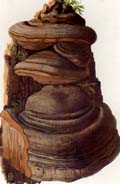Cerrena unicolor
 Key to Gilled Mushrooms Key
Key to Gilled Mushrooms KeyThis is a key to gilled mushrooms, that is, mushrooms having a definite cap with a fertile surface consisting of gills. The fruiting body usually also has a stem, although that may be lateral or absent (usually, then, the mushroom is growing from wood). You can use this key to identify mushrooms that you find.
 Polyporaceae Family
Polyporaceae FamilyFertile surface usually a layer of vertical tubes, of which the mouths are visible as pores on the underside of the cap or shelf.
Fruiting bodies usually tougher or harder than the "normal" gilled mushrooms, being leathery, corky, or woody. But they can be quite tender while actively growing
Once grown, they do not decay easily, remaining on the substrate for months or years
They often grow on wood, although a few are terrestrial (even those are usually growing on buried wood)
Fruiting body is usually a flat shelf, or hoof-shaped, protruding directly from the substrate, although sometimes it may have a short stalk.
Some forms never grow away from the substrate at all, so that all that is visible of the fruiting body are the pores.
Sometimes the pores are so minute that the fertile surface seems solid, until you look closely
 Lignicopolypore Subfamily
Lignicopolypore SubfamilyGrowing on wood
 Maze-o-porus Tribe
Maze-o-porus TribeFungi with a hymenophore of irregular, interweaving plates that divide the space between them into long, twisting chambers and maze-like passageways.
Usually the plates are quite hard and woody, sometimes just tough, never as soft and fragile as the gills on gilled mushrooms
 Wood-o-maze-o-porus Subtribe
Wood-o-maze-o-porus SubtribeTop concentrically wrinkled, with the appearance of zoned wood, though perhaps a little bit hairy
 Daedaleoporus SemiTribe
Daedaleoporus SemiTribe
 Cerrena Genus
Cerrena GenusFruiting body duplex; brown, gray or white on top; may be furry, often with algae or moss growing on it
Flesh is thin (up to 3 mm) and white.
Hymenophore starts out ivory, darkens to greyish or even black with age, and breaks up in age into separate teeth
Here are the characters that distinguish this species from the others in its group. For its more general characters, see higher up on the page.
If there's just a few words or a microscopic feature here, a more thorough description can be found above.

Diagnosis
- Up to 3" across
-
If you have something bigger, try Trametes






 Key to Gilled Mushrooms Key
Key to Gilled Mushrooms Key Polyporaceae Family
Polyporaceae Family Wood-o-maze-o-porus Subtribe
Wood-o-maze-o-porus Subtribe Daedaleoporus SemiTribe
Daedaleoporus SemiTribe Cerrena Genus
Cerrena Genus





